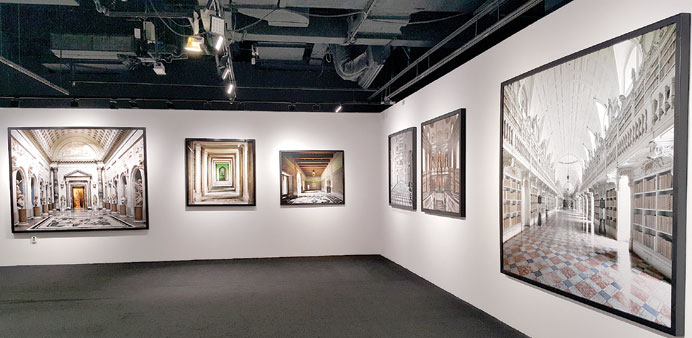MONUMENTAL: Some of Massimo Listri’s photographs at the Katara exhibition.
Regarded as a master of interior photography, Florence-based Massimo
Listri’s frames, displayed at Katara, are simply spellbinding. By Anand Holla
How does one make something inherently beautiful achieve its full potential of glory and grandeur? Italian photographer Massimo Listri might be one of the very few artistes in the world today who can flawlessly demonstrate this magical possibility.
Regarded as a master of interior photography, Florence-based Listri, for 30 years, has been snapping up awe-inspiring images of some of Europe’s biggest and finest public spaces with no human presence in them. To get an up-close look at his photographic genius, take a good, long look at Listri’s photography exhibition at Katara, Building 22, Gallery 2, which is on till November 15.
By spending endless hours exploring the world’s most incredible castles, palaces, villas, hidden gardens, libraries, convents, monasteries, and universities, the “scenographer” has imbibed an evolved understanding of how best to photograph marvellous interiors even though he has experimented with everything else as well.
It’s almost magical how Listri infuses new life and light into the interiors of magnificent architecture, thereby telling stories about the place that seemed to have been shrouded in shadows before. Also, it’s possibly the best that these interiors can possible look as Listri is proficient at figuring out exactly how light enters and illuminates each surface, and how a photographer must harness it to his or her advantage.
“It is purely a question of sensibility. The secret is in the light which highlights the details. That’s why I definitely prefer to use natural light when possible,” Listri believes.
Some of his photographs that are on display at the exhibition are of Capodimonte Sala da Ballo, Napoli; Palazzo Ducale, Massa; Kunsthistoriches Museum II, Vienna; Auditorium Ibirapuera Oscar Niemeyer, Sao Paulo, Brazil; and Castello di Schwetzingen V, Baden-Württemberg in Germany.
Listri’s photographs of these stunning interiors ring with palpable silence, possessing some sort of a mysterious noise-cancelling feature that blanks you out from your mental and physical environment and draws you into the details of the beauty that lay stretched before you.
All of 16 when he first discovered his passion for photography, Listri was spurred on by the books and magazines that his father, a journalist and literary critic, used to receive at the family home. Easy access to the latest materials presented him with the opportunity “to discover the world of arts and photography and literally fall in love.” Listri has travelled across the world with his work; from London and New York to Hong Kong and Bangkok.
When the website Yatzer asked Listri about his privilege of getting to photograph unique and restricted places such as the Vatican Museum in Rome and Palazzo Pitti in Florence, he said, “My photography is an expression of tranquility and silence in this chaotic society – a sense of perspective and equilibrium. This is therapy for the soul. Every time I take a photo is like the first time a treasure is revealed, a first emotion, be it an empty room or the greatest treasures of the Vatican.”
Asked further about what is more important to him, the technique or the intuition, Listri responded, “Intuition is something you cannot learn, it is your emotions, the way you look at your subject. Technique is just a tool which we all have to learn at the beginning of our career.”
Listri’s work often presents interiors of great architectural and cultural importance and his photographs have been exhibited in numerous public and private institutions, including Palazzo Reale, Milan; Palazzo Pitti, Florence; and Centro per ‘larte contemporanea Luigi Pecci, Prato. Over his career, he has produced 58 books on art and architecture.
If you ask Listri about formulas or rules, as Yatzer did, his response would be: “Proust wrote that acts of creativity do not have laws of precedence. It is an instinct, a great, obscure and incomprehensible power that can never be repeated. Each occasion, each photo is just unique.”



